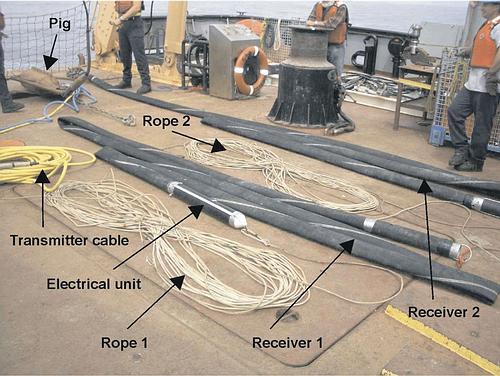 Web Content Display Web Content Display
CSEMA CSEM experiment will be complementing the MT data on a shallow scale. Next to investigating the fluid distribution and vent fields in the upper crust we are also interested in the methane hydrate layer. Gas hydrates within the continental slope are not only of commercial interest, but are also important for the stability of the slope. We intend to build a seafloor system in conjunction with University of Toronto. Such a system has been successfully employed to explore methane hydrate deposits on the Chile Margin and Cascadia Margin. An overview paper on marine CSEM has been presented by Prof. Edwards at the EM Induction workshop in Hyderabad and can be downloaded here.
Geometry and deck assembly of the University of Toronto inline electric dipole-dipole system. The instru-ment consists of a transmitter bipole (long dipole) and two receiver dipoles. The transmitter cable (yellow) is a 120m long coax cable with electrodes on each end to pass on the electric signal. Each receiver consists of a 15m long rubber hose with non-polarizable electrodes mounted inside each end to measure the voltage difference. An electrical unit is attached to the close end of each receiver which contains a data logger, a clock, battery packs and filter boards within a pressure cylinder. Photo courtesy of R.N. Edwards and K. Schwalenberg. |
 Events Events
Kieler Wissenschaftler fühlen den 'Puls der Erde' Wie funktioniert die Recyclingmaschine der Erde?Nach elf Jahren endet der Kieler Sonderforschungsbereich 574 zu Subduktionszonen Final colloquium of SFB 574 Teilprojekt ÖffentlichkeitsarbeitMEERESFORSCHUNG FÜR MICH UND DICH |
|
©SFB574 // Wischhofstrasse 1-3 // D-24148 Kiel // T. +49 (0)431 600 1413 // elange [AT] geomar.de






